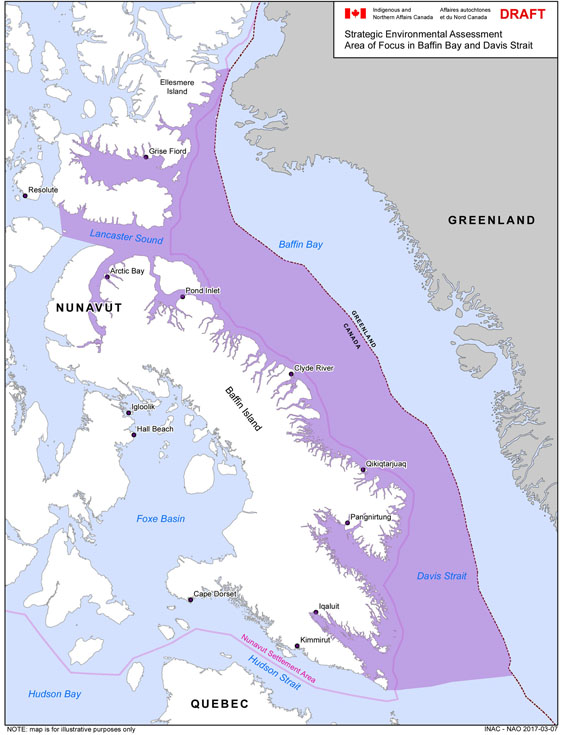Clyde River group says it needs funding to participate in Nunavut oil-gas study
Clyde River’s hunters and trappers group is in urgent need of money to fund its participation in the federal government’s assessment of potential offshore oil and gas development east of Baffin Island, the group said Aug. 4 in a letter to the Nunavut Impact Review Board.
“Oil and gas is clearly very controversial in our community and we have many concerns that need to be addressed. However, we require significant funding to meaningfully participate,” the Clyde River Hunters and Trappers Organization said in the letter, signed by its current chair, Jerry Natanine.
Furthermore, “deep consultation” with Indigenous people, as defined by the Supreme Court of Canada, includes participant funding and that means Ottawa must provide the money to Clyde River, the letter said.

After a false start in 2013, the strategic environmental assessment, or SEA, for Davis Strait and Baffin Bay got going in earnest this past February, when Indigenous and Northern Affairs Canada announced the NIRB would lead it.
That big study, to be completed by March 2019, is expected to help the federal government decide whether to invite companies to bid on permits for offshore oil and gas exploration in the waters off eastern Baffin Island.
Ten of the Qikiqtani region’s 13 communities—Resolute Bay, Grise Fiord, Arctic Bay, Pond Inlet, Clyde River, Qikiqtarjuaq, Pangnirtung, Iqaluit, Kimmirut, and Cape Dorset—lie within the area covered by the SEA.
So the NIRB got its work started on the SEA this past April and May by scheduling public meetings in all 10 of those communities.
Those sessions generated questions and comments in nine communities, but in Iqaluit, nobody bothered to show up to the NIRB meeting scheduled for May 13. (See document embedded below.)
This fall, the NIRB will follow up on that first round of community meetings with work on the scope of the SEA, the project’s first phase. To do that, they’ll release a draft “scoping” document listing all the potential factors an SEA should consider.
After more meetings in the 10 affected communities, the NIRB hopes to complete a final “scope” for the SEA process by about February of 2018.
But the Clyde River HTO said that to “meaningfully participate” in the SEA, they need funding and they need it right away.
For starters, they need $35,000 just to pay for their participation in the scoping phase, the Clyde River HTO said in their letter.
“During the initial scoping phase of the assessment, we will incur expenses for hosting community workshops to document community concerns, consultant and legal fees to help review draft scoping documents and travel fees for legal counsel and consultants to attend scoping workshops,” the HTO said.
And in later phases of the SEA process, the Clyde River HTO will need more money to pay for lawyers, researchers and consultants, who would help review submissions made to the NIRB by other groups.
“We have yet to determine what our costs will be for the later stages of the review,” the letter said.
In their request, the Clyde River HTO cited the Supreme Court of Canada’s recent decision to overturn a permit the National Energy Board issued in June 2014 to a consortium of three Norwegian companies for a seismic testing project for five years in Davis Strait and Baffin Bay.
In that ruling, the Supreme Court said the Crown must conduct “deep consultation” on development projects that pose a potential risk to Indigenous rights.
“Courts have repeatedly ruled that Inuit are owed ‘deep’ consultation when oil-gas development in Baffin Bay and Davis Strait are concerned,” the HTO said.
“The Supreme Court of Canada has also repeatedly stated that deep consultation often requires the Crown to provide funding to aboriginal groups to allow them to participate in environmental reviews and licencing processes.”
The HTO also warns that if they can’t get their funding by September 2017, “we will be unable to meaningfully participate in the scoping phase of this review.”
So far, no other groups appear to have asked for intervenor funding in connection with Ottawa’s strategic environmental assessment for Baffin Bay and Davis Strait.
But the NIRB’s work on the SEA will likely continue until at least early 2019.
They plan a series of two-day meetings in each of the 10 affected communities this fall and expect to produce a final document by March 2018 that sets out the scope of the process.
After that, Phase 2 of the SEA process will begin, looking at what they call “potential development scenarios.”
That phase, expected to last about six months, will involve more community meetings leading up to the production of a document called the “Final Potential Development Scenarios Report.”
Phase 3, also expected to take about six months, will involve final written submissions from interested parties and lead to a five-day final public meeting and community roundtable, followed by the production of a final SEA report.
At the end it of all, the NIRB will send that report to the INAC minister and await the minister’s response.
Right now, Baffin Bay and Davis Strait are off-limits to exploratory drilling for oil and gas.
That’s because Prime Minister Justin Trudeau promised on Dec. 20, 2016 that the federal government will no new offshore oil and gas leases in the eastern Arctic for five years, under the moratorium that Prime Minister Justin Trudeau announced on Dec. 20, 2016.
The Baffin Bay-Davis Strait SEA is expected to become a “key consideration” in the five-year review of that moratorium that Ottawa promised in Trudeau’s announcement, Stephen Van Dine, an assistant deputy minister in the INAC department, told the NIRB in a letter this past February.